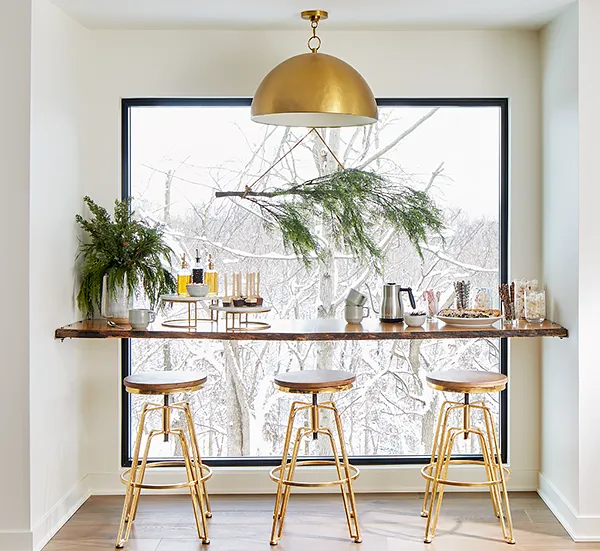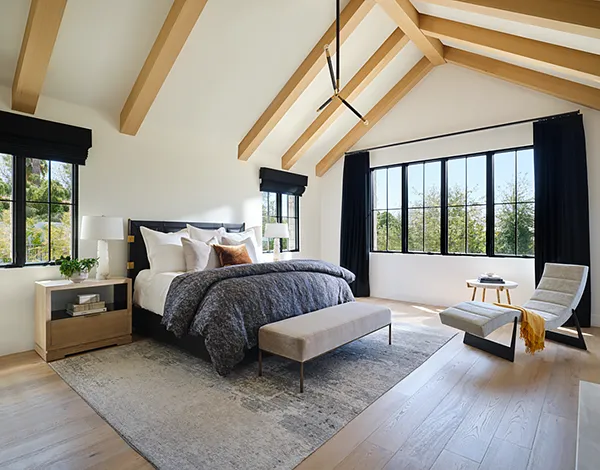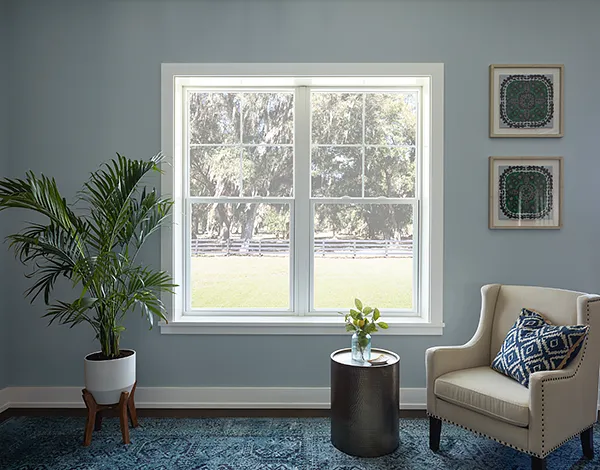How Windows Can Improve Your Home's Energy Usage
by Rachel Lyon, Editorial Director for Direct from the Designers
As cooler temperatures set in, you might notice a chilling draft by your windows. That harbinger of winter is just the beginning of months of higher utility costs for many of us, but it doesn’t have to be that way. When you invest in quality windows, you can slash heat loss and facilitate passive solar heat gain, so they are a major asset of energy-efficient design. Here’s how to select the best windows for your needs!

The Most Inherently Efficient Window Types
Before getting into the technical specifics that affect window performance, there are some kinds that are more efficient based on construction alone. Window seals are potential weak points, so consider how windows open. Fixed windows—often called picture or direct glazed windows—do not open at all, as the glass is attached directly to the frame. They are exceptionally efficient as a result, but your home also needs operational windows for fresh air and emergency egress. Hinged windows—like casement and awning—have weatherstripping that presses to a seal between the window sash and its frame when locked closed, but sliding windows—like double hung and side-to-side sliders—are made of sashes that pass beside one another within the frame, and they require flexible seals as a result. You can understand how structure produces an efficiency difference between a window that creates its own compression seals and one that must have seals supple enough to allow movement.
When you think about the history of windows and house styles, you’ll find that as glass manufacturing improved, modern architecture took off. And if you know anything about modern homes, they are defined by their ample use of windows. If you’re going to choose a home with that much glass, it had better be efficient! That’s one reason why fixed and hinged windows are typically chosen for these applications, while single and double hung window styles are primarily used for their historically accurate looks on older, traditional architecture. Remember that windows weren’t nearly as large in the past, and if you love the classic appearance but also want the broader expanses of glass that we prefer now, you should weigh the pros and cons from an efficiency and stylistic standpoint. For the sake of their utility costs, many people have opted for casement windows with divided lites to get the best of both worlds, but advanced engineering means that high quality sliding windows are also much more efficient these days than they were in the past.

Durable Materials with Low Thermal Conductivity
A lot of the time, the draftiness you feel around windows isn’t actually an indicator of air movement. If the pane of glass or its frame is thermally conductive, the high radiation rate is why you feel the temperature transfer. Explore options to minimize this rate and maximize efficiency.
Frame material can make or break window efficiency. Aluminum is often chosen because it is lightweight and practically maintenance-free, but you know exactly how cold metal gets in the winter. You’d much rather handle wood in low temperatures, but wood frames require regular upkeep to prevent degradation from the elements. Put these two together and you can make a fantastic window that is less thermally conductive than metal and more durable than wood.
Synthetic materials are available, too. Vinyl is popular because it is affordable, low-maintenance, and durable, but inferior versions give the whole category a bad rap. Interior vinyl can be brittle in the cold, warp in strong direct sunlight, and expand and contract at a higher rate than glass, meaning that seasonal temperature swings can break insulating seals around the panes. Invest in a high-quality formula and smart design to overcome environmental challenges! Quality vinyl windows stand up to all weather conditions, are reinforced and welded to resist warping, and feature a multi-chambered frame with air pockets to slow heat transfer.
Fiberglass is another synthetic option, and it is the strongest and best insulator among window frame materials. It is a thermoset polymer, meaning it is more rigid and much less prone to thermal expansion than vinyl. Fiberglass shrinks and expands at the same rate as glass, which makes its seals as durable as the rest of the unit. As a result, it offers great performance even in extremely hot and cold conditions and big temperature swings. While fiberglass has a higher price tag upfront, it will save over time thanks to its durability and efficiency. No wonder it's the top choice for commercial applications!
As far as glass goes, double panes with insulating gas have become standard. The gap between the panes creates a temperature buffer on its own, but adding argon gas further decreases heat transfer. Tripane windows are available for the super energy conscious consumer, but they do come at a higher cost. Whether it’s double or triple paned, the glass itself isn’t often the problem, and that’s why efficiency usually comes down to the quality of the frame. You need to compare U-factors—which measure the heat transmittance of the entire window unit—to determine the efficiency, but they don’t account for frame durability. The lower the U-factor, the smaller the heat transfer and the greater the efficiency, but that doesn’t mean much if the frame rots, warps, or expands and contracts to break the seals in a few years. It’s up to you to look beyond the U-factor to determine which windows will remain efficient for the long term.

Maximizing Efficiency with the Right Glazing
While everybody can appreciate windows that are durable and provide a good level of insulative power, there is no "one size fits all" solution. In addition to multiple panes with insulating gases and a range of frame materials, modern technology has added another variable: glazing. You can’t see the microscopically thin metallic glaze applied to the glass, but it plays a crucial role in controlling the exchange between indoor and outdoor environments and contributes to both the U-factor and the Solar Heat Gain Coefficient (SHGC).
Low-emissivity (Low-E) coatings are selected based on climate zones to optimize windows for their surrounding conditions. Low-E glass tailored for northern climates, for instance, provides a low U-factor and has a high SHGC; it reflects indoor heat back to prevent loss to the outdoors and allows the sun’s heat inside. On the other hand, Low-E glass optimized for hot southern areas has a low U-factor and a low SHGC, meaning it insulates well and reflects the sun’s warmth away. If you don’t know which glaze is best for your needs, you should consult with a professional who will take location and home orientation into account.
So, if glazing affects heat flow, can it overcome the window’s reputation for being the weakest link in the building envelope? If you play your cards right, absolutely! While insulation in exterior walls slows heat transfer in both directions indiscriminately, glazing directs heat where it’s wanted to improve the whole home’s efficiency. So, if you want large windows to take in views or lots of natural light in a northern location that gets very cold, opt for a suitable Low-E coating and point the majority of your windows due south. That way, you get light and the extra boost of free solar heating. In southern climates where reducing cooling costs is the major concern, you'll really appreciate windows that block the sun's heat. When you invest in quality materials that can withstand the conditions and help you overcome them, your home can rely less on the HVAC system and save money for many years.
If you’re ready to make that investment, check out the wide variety of windows from Pella®. With plenty of shapes, styles, and finishes to explore, you can get lost in the design possibilities without worrying about utility, because this brand is committed to energy efficiency and can help you select the best products for your needs. Schedule a free consultation and start your journey to a more environmentally friendly home!
BROWSE HOME PRODUCT ARTICLES
- Creating a Spa-Like Master Bathroom »
- Designing a Water-Efficient Bathroom »
- Design a Modern Bathroom »
- View All Bathroom Articles »
- Building a New Home »
- Building a Duplex »
- Finding the Right Home Builder »
- View All Building Tips Articles »
- Adding the Right Columns»
- Decorative Touches for Your Interior»
- Shutters for Every Architectural Style »
- View All Columns & Millwork Articles »
- How to Use Specialty Laminates »
- Decorative Touches for Your Home's Interior
- View All Countertops and Surfaces Articles »
- What Goes Into a Great Deck? »
- Decorative Touches for Your Home's Interior »
- View All Decking Articles »
- Choosing Glass for Your Entry »
- Stylish Personas for Your Front Door »
- Using Sidelites and Transoms »
- View All Door Articles »
- Choose Siding for Your Region »
- Get the Most Out of Exterior Paint »
- Mixing Siding to Define Your Exterior »
- View All Exterior Articles »
- Finding the Right Home Builder »
- The Appeal of Small House Plans »
- Choosing the Perfect Floor Plan »
- View All Finding a Home Plan Articles »
- Colorful Flooring for Your Home »
- Designing With Different Widths»
- Chic, Neutral, Gray Flooring »
- View All Flooring Articles »
- Garage Doors That Add Curb Appeal »
- Caring for Your Garage Doors »
- Benefits of Insulated Garage Doors »
- View All Garage Door Articles »
- Reclaimed Products for Your Home »
- Building a Green and Stylish Home »
- Benefits of Building with SIPS »
- View All Green Building Articles »
- Cool Gadgets for Your New Home »
- Creating a Hi-Tech Home »
- Efficient Gifts for New Homeowners »
- View All Home Electronics Articles »
- Improve Your Home's Air Circulation »
- How to Improve the Air Circulation in Your Home »
- View All HVAC Articles »
- Bedrooms Designed for Sleep »
- Selecting a Fireplace for Your Home »
- Crafting a Luxurious Master Suite »
- View All Interior Design Articles »
- Design the Perfect Outdoor Space »
- Dive into a Beautiful Pool »
- Design a Sizzling Outdoor Kitchen »
- View All Outdoor Living Articles »
- Apps to Help You Pick Paint Colors »
- Create the Perfect Mood with Paint »
- How to Read the Color Wheel »
- View All Painting & Decorating Articles»
- Creating a Spa-Like Master Bathroom »
- High-Impact Kitchen Upgrades »
- Creating a Water Efficient Bathroom »
- View All Plumbing Fixtures Articles»
- Cladding That Complements Your Exterior »
- Reasons to Consider Prefinished Siding »
- View All Siding & Cladding Articles»
- All About Solar Powered Skylights »
- Natural Lighting for the Dark Corners of Your Home »
- Design a Better Bedroom with Skylights »
- View All Skylight Articles»
